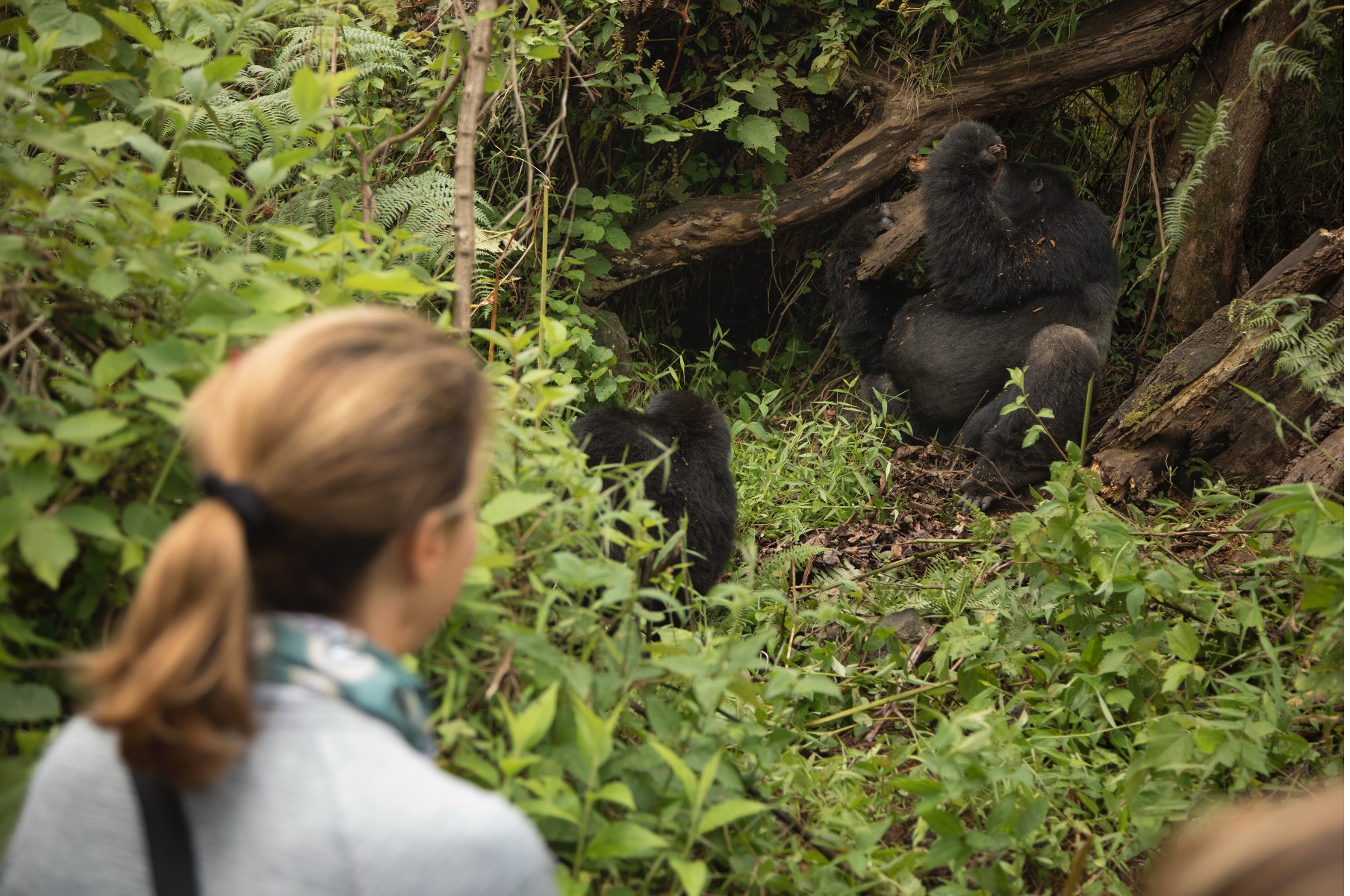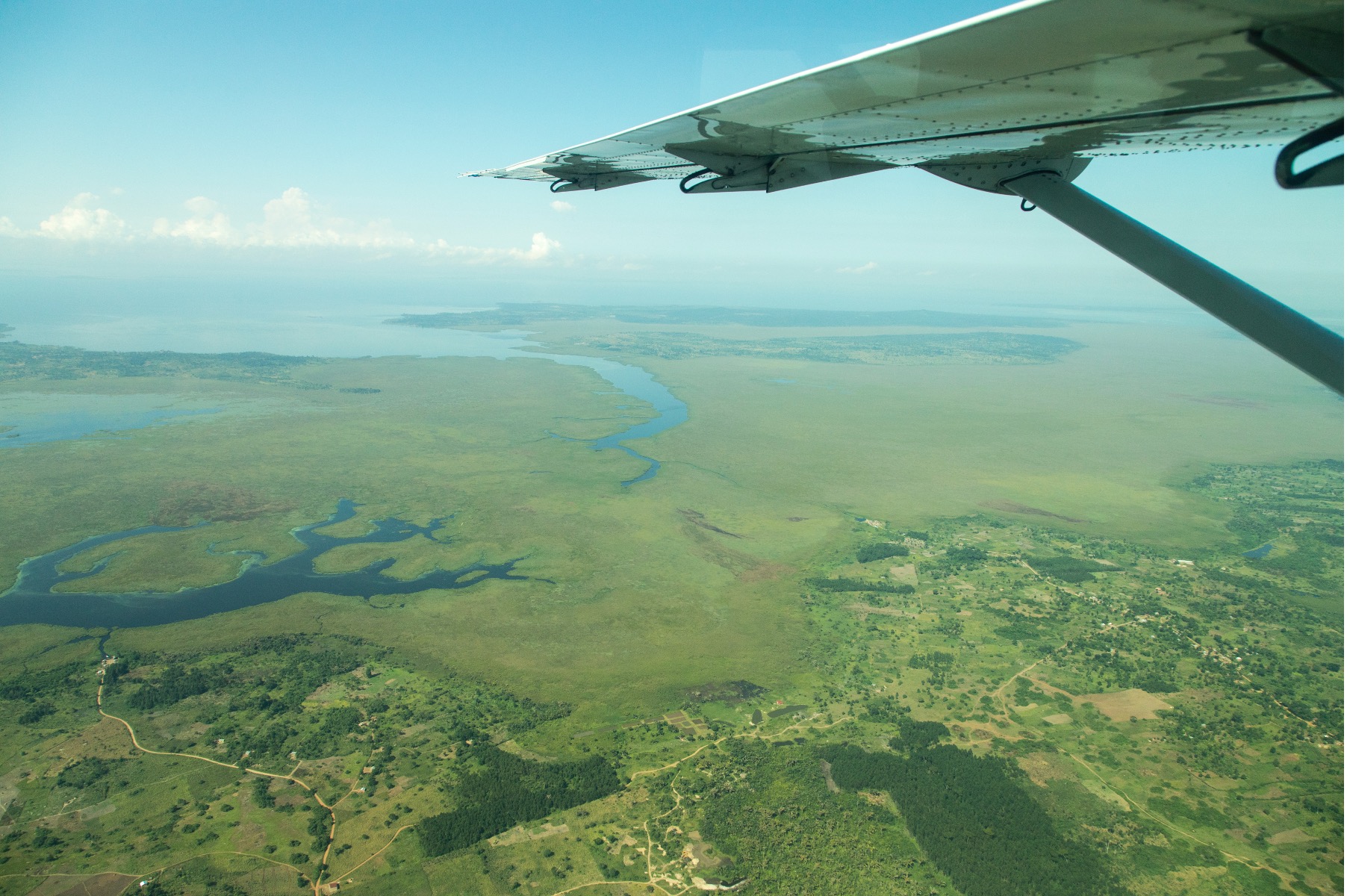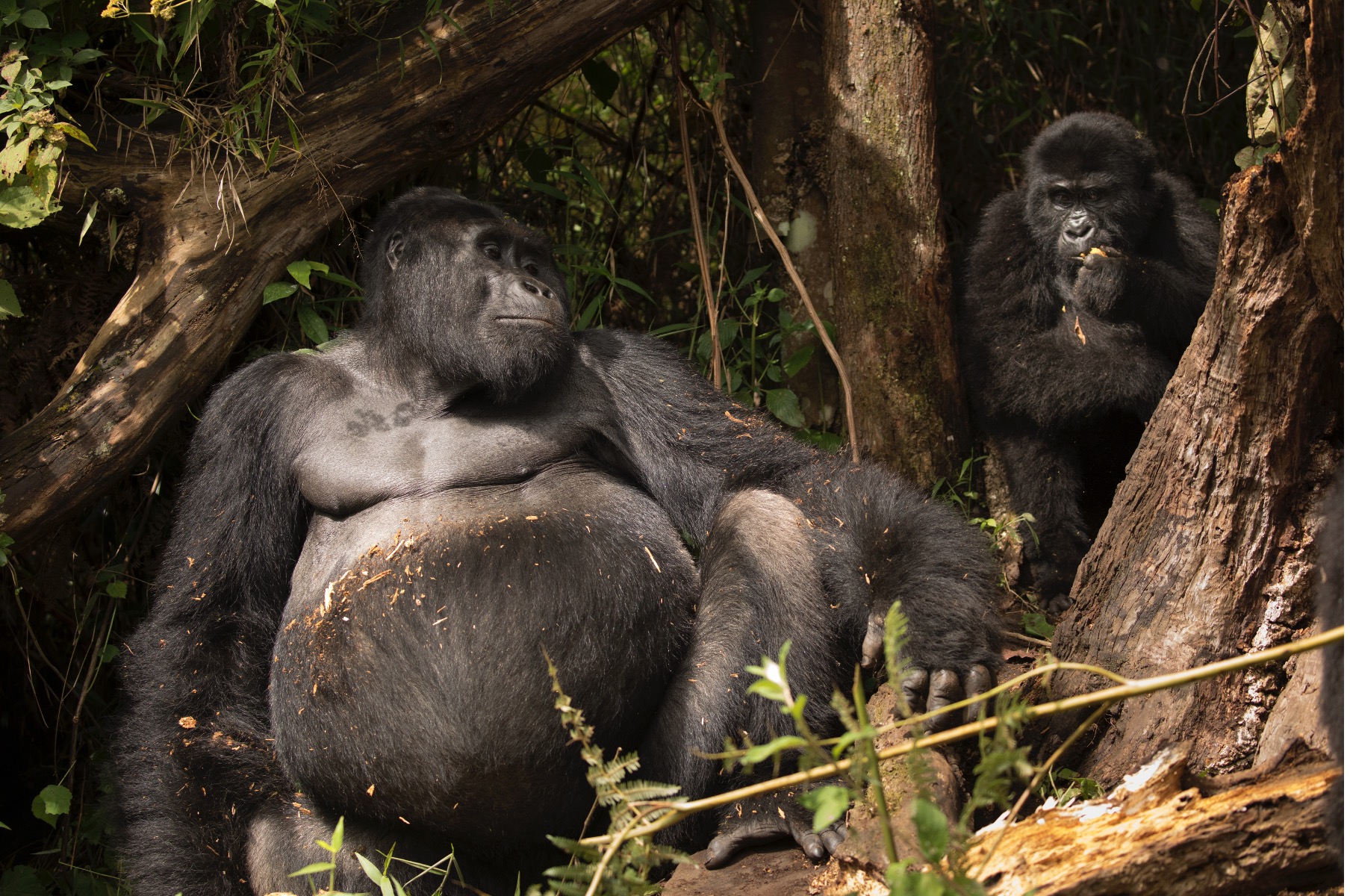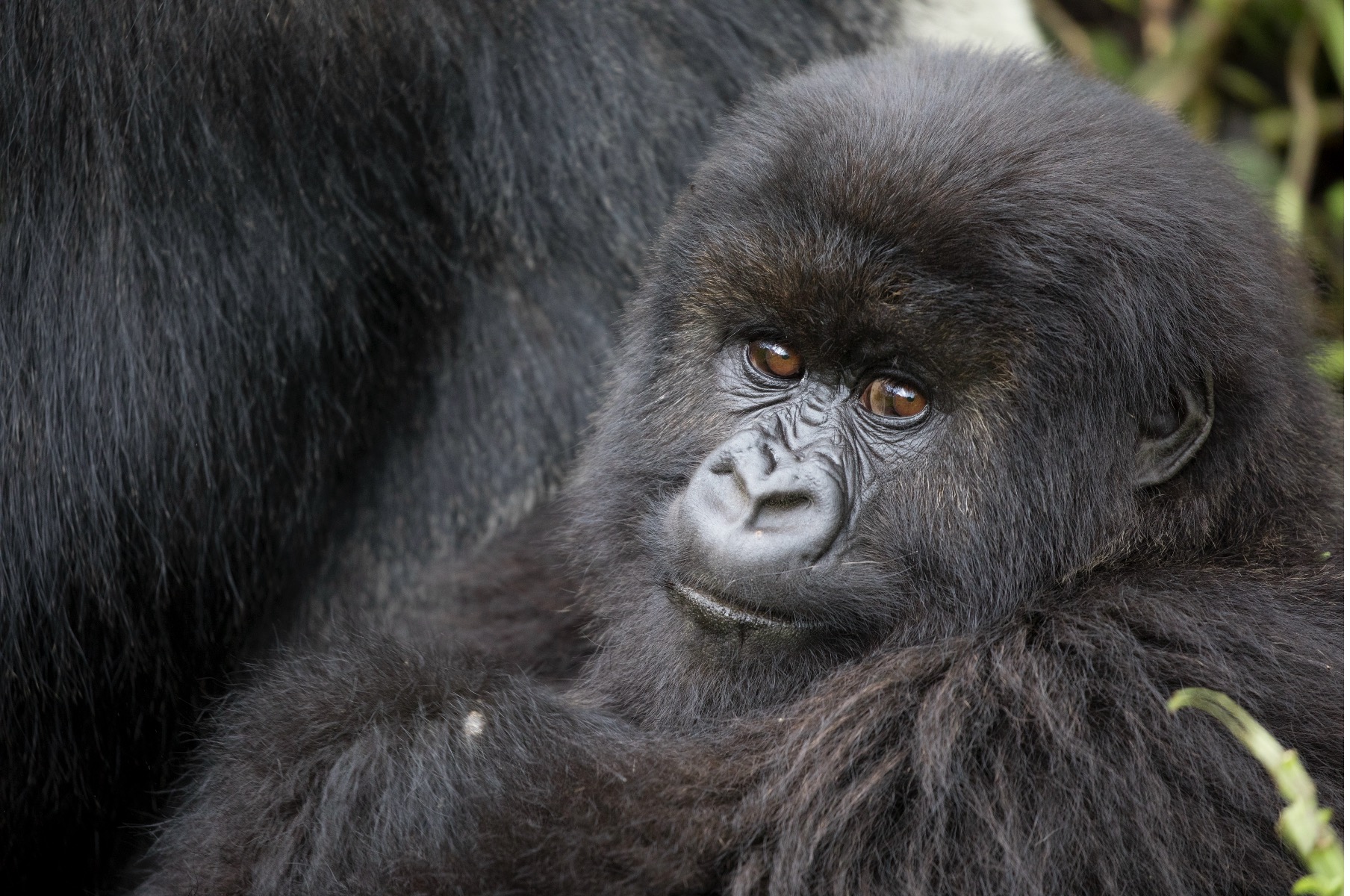
What’s in My Camera Bag? Gorilla Photo Safari
There are lots of superlatives we give to worldwide nature photo adventures, and it’s hard to say that one is better than the other. However, anyone that has photographed mountain gorillas in the wild will tell you that there is something supremely special, show-topping, and incomparable about such a photo experience.
Read on to get the latest on camera gear recommendations for this truly ultimate photo experience.
Please note, photographic styles vary, as do conditions on the ground. While this is meant to be a guide for choosing your camera gear, you should consider your own photographic interests first and foremost.

Wide Angle Zoom
You really shouldn’t go anywhere without a solid wide angle zoom. You know–you’re “walking around” lens like an 18-55mm (crop frame), 24-70mm, or 24-105mm (full frame). This lens will be used each and every day, whether it’s photographing dramatic landscapes while hiking (or even from small planes) or photographing gorillas and other primates to showcase habitat.
This may not be the most crucial lens, but it’s up there—don’t leave home without it if you’re headed on a gorilla photo safari!

A Zoom Telephoto
Even though you’re going to be really close to gorillas, a high quality zoom telephoto is going to be your best friend. Having the versatility of zooming in and out, mixed with some moderate to high focal length (like, 200mm, 300mm, or 400mm), is going to allow you to a) shoot wide to get multiple gorillas in the frame, or showcase some habitat, but also, b) allow you to zoom in and fill the frame with just one gorilla or even just a gorillas face.
But here is the kicker, to bring “the best” lens, you’re likely going to have to compromise—I know, I’m sorry.
Where gorillas live and play can be quite dimly lit and/or brushy with lots of vegetation and “distractions.” As a result, having a “fast” lens is a huge benefit.
So, what lens would be great to a) give you some versatility with zoom and telephoto, b) allows for a shallow depth of field (aka “fast”), and c) can allow in a decent amount of light in dimly lit environments?
Enter the 70-200mm f/2.8.
In my opinion, this lens has the most features you want in a single lens.
The only downside, if there is one, is that something like a 300mm would make it darn near perfect. The telephoto extent of a 200mm is good, but if you want to get some shots of zoomed-in, filling-the-frame gorilla faces, a 300mm or 400mm is necessary. BUT, it’s hard to find a 300mm or 400mm that gives you zoom range (i.e., isn’t fixed or considered a “prime” lens) while also giving you that big aperture of f/2.8.
One caveat for the pros out there…Canon recently released a high-end 100-300mm f/2.8, which makes this lens pretty darn near perfect. The only downside is that it’s about a $10,000 price tag (but I would consider renting it from LensRentals.com if you’re a serious photographer). For those of you with Olympus systems (now called OM Systems) the 40-150mm f/2.8, which is an 80-300mm f/2.8 on full frame, is absolutely perfect.
So, to me, having that shallow depth of field is really important for great gorilla photography. The f/5.6 or f/6.3 that most zoom telephotos give you at 400mm isn’t going to look nearly as good as the f/2.8, and I’m ok cropping my photos in a little bit.
Yes, you can set your ISO higher for the low light aspect of gorilla photography, but the shallow depth of field is the primary reason I’m recommending an f/2.8 lens.

What about a Super Telephoto?
Just to get terminology out of the way here, I am personally referring to telephotos of 500mm and above when I talk about a Super Telephoto.
Are they useful? Heck ya? Are they critical? Sorta. Should you consider bringing one? It depends…

For many gorilla safaris in East Africa, you will experience more than just gorillas (I hesitate putting “just” in front of gorillas, FYI). There are solid safari areas with traditional wildlife like elephants, hippos, lions, and more. For these instances, a super telephoto is a really nice addition to your kit. However, if it’s one of the big prime lenses that weigh a ton, you will likely leave it back while doing your gorillas trekking.
However, if you have one of the new smaller super telephoto zooms, like a 150-600mm, this pairs WONDERFULLY with a 70-200mm f/2.8 for gorilla photography. Why not have the additional telephoto power. It’s rare to ever say you wish you had less telephoto power with a zoom lens.
In addition, more telephoto power can help you with background (and foreground) blur when you simply don’t have a lens with f/2.8 capabilities. Check out the below photo, which was at 400mm f/5.6. You still get some nice blur even with f/5.6, but you need to use as much telephoto as possible to achieve this, which isn’t ideal in all gorilla photography scenarios.

X-factor Lenses
Thinking differently is an excellent mindset when climbing the ranks of great photographers. One way to think (and shoot) differently is to think of weird lenses that might actually turn out pretty good on a photo trip.
For mountain gorilla photography, my mind immediately goes to portrait lenses with wildly shallow depths of field. I’m talking about your 50mm f/1.4, 85mm f/1.2, and maybe even the 135mm f/1.8 lenses.
As you can immediately tell, these are all prime lenses that do not zoom. This puts you at an immediate disadvantage. However, what they lack in versatility they more than make up for in creativity.
The shallow depths of field you can achieve from these low f/numbers is staggering. And frankly there aren’t many places in the world these lenses work well for outside of people photography. However, the size of gorillas, mixed with the proximity with which we can photograph them, makes this one of those rare treats.

These lenses can be expensive and surprisingly heavy for what they are, but if I were to bring any lens that isn’t totally necessary, but can produce stunning results in the right time and right place it’s the 85mm f/1.2.
I’ve personally never shot with it when with gorillas, but I’m absolutely going to try next time I head to Uganda or Rwanda for these amazing photo trips.
Accessories and Other Gear
Rain protection and general camera protection is a good thing to think about right off the bat. These forests of East Africa can be quite humid and a rain shower can happen even in the middle of the dry season. Think about a rain cover for your backpack or other camera protection as you plan for this trip.
I don’t typically bring a tripod with me to places that are primarily wildlife focused. While one could be useful in low light scenarios, the gorillas really move just too much to shoot at slow shutter speeds. Plus, the terrain is way too undulating to get a stable base. I leave mine at home.

One final consideration is a second camera body. In addition to having it as a backup if something goes wrong with your primary body, you will likely get twice (or nearly so) the shots you’d get with just one body and one lens. Having a 70-200 on one body and a 24-70 on the other is a stunning combo. Or, a 70-200 and a 100-400 to really focus on the close shots. There are of course many other combos you can have here, but the point is that a second body is a particularly nice thing to have for a gorilla photo tour if you are a serious photographer.
More than anything I hope you’re reading this because you have an epic gorilla photo adventure planned, or are in the planning stages now! You are sure to have a trip of a lifetime and with a little bit of help and guidance here, the photos to prove it!!
All the best,

Court
4 Comments

Grant China
March 17, 2024 at 3:29 am

Court Whelan, Ph.D.
March 28, 2024 at 9:30 am

John
June 1, 2024 at 8:48 am

Court Whelan, Ph.D.
June 21, 2024 at 7:53 am
I completely second the idea of taking a second body for gorillas. I had a 70-300mm f/4-5.6 with me on a crop body, a 7D, and 112mm equivalent on the short end was just too much reach for a lot of shots. The gorillas can get surprisingly close to you and they are large animals.
At least the day that I went to see gorillas had good lighting. A few days earlier we saw chimps and I was glad to have the extra reach there. But they were under very heavy canopy and the lighting was really poor. (And of course, the7D was notoriously noisy in poor lighting.)
love it, thanks, Grant!! Such a cool adventure 🙂
Thanks for your article. This was mine one million dollar question: should I leave mine 85mm1.2 home or not? You gave me the answer.
great to hear!! Happy to help 🙂